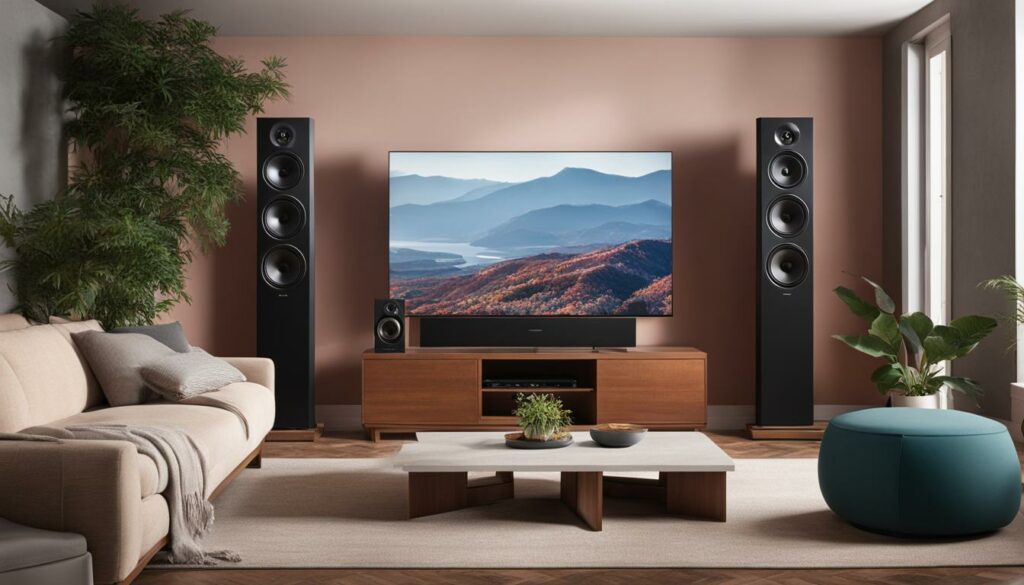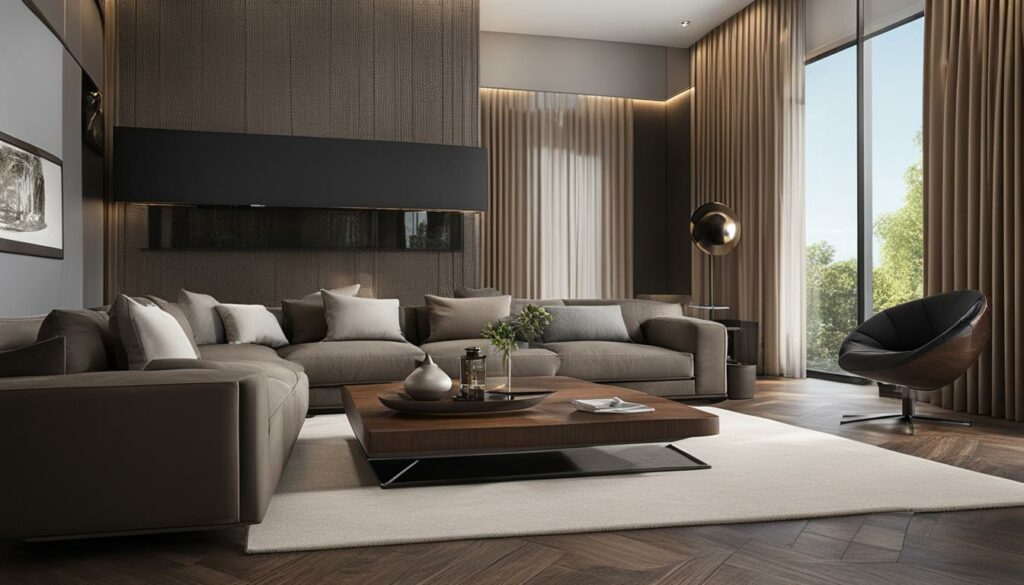
Proper speaker placement is crucial for an immersive and enjoyable listening experience. Whether you’re a music lover, a movie enthusiast, or simply want to enhance your audio system’s performance, finding the optimal distance to sit from your speakers is essential.
When it comes to speaker placement, there are guidelines to help you achieve the best sound quality. From the tonal balance to the soundstage width and depth, these factors can greatly impact your audio experience. In this article, we will explore the importance of speaker placement and provide you with practical tips to make the most out of your stereo speakers.
Key Takeaways:
- Finding the optimal distance to sit from your speakers is crucial for an immersive listening experience.
- Proper speaker placement allows for accurate stereo imaging and minimizes sound reflections.
- Follow speaker placement guidelines to optimize tonal balance, soundstage width and depth, and midrange clarity.
- Consider factors such as room symmetry, speaker separation, toe-in angle, and speaker height for optimal sound.
- Regardless of your audio equipment, correct speaker placement is essential to hear sound as intended.
The Importance of Speaker Placement
Proper speaker placement plays a crucial role in creating an optimal listening experience. It not only enhances the stereo imaging but also minimizes sound reflections, resulting in a more immersive and accurate sound reproduction.
When speakers are placed correctly, they can deliver an accurate stereo image, where each sound comes from its intended location. This allows you to perceive the music as it was intended by the artist, creating a more engaging and captivating atmosphere.
Accurate stereo imaging also helps to avoid instrument overlap and blending, ensuring that each instrument retains its distinct character and presence. By positioning your speakers in such a way that they reproduce sound from different places, you can create a more realistic and three-dimensional soundstage.
Moreover, proper speaker placement helps to minimize sound reflections, which can negatively impact the overall audio quality. Sound reflections can result in time smearing, causing the music to sound muddy and unclear. By reducing the impact of these reflections, you can achieve a clearer and more precise stereo image.
By following speaker placement guidelines, you can optimize the positioning of your speakers to ensure an optimal listening experience. Whether you are setting up a stereo system or a home theater, paying attention to speaker placement will significantly enhance your enjoyment of music, movies, and other audio content.
Tips for Speaker Placement from The Complete Guide to High-End Audio
The positioning of your speakers and the listening seat plays a crucial role in achieving the best sound from your system. The Complete Guide to High-End Audio offers some valuable tips to help you optimize your speaker placement for an exceptional audio experience.
- Loudspeaker Positioning: Place your speakers at an equal distance from the side walls and ensure that they are angled towards the listening position. This creates an accurate soundstage width and depth, enhancing your overall listening experience.
- Tonal Balance: Position your speakers to achieve a balanced tonal output. Experiment with different placements to find the sweet spot where the highs, mids, and bass frequencies blend seamlessly.
- Bass Quantity and Quality: Proper speaker placement can significantly impact the bass response. Placing the speakers closer to the wall can enhance bass quantity, while pulling them away can improve bass quality and reduce muddiness.
- Midrange Clarity: To ensure clear and detailed midrange reproduction, position your speakers at ear level and away from any obstructions. This allows the midrange frequencies to reach your ears unobstructed, resulting in a more vibrant and natural sound.
- Soundstage Width and Depth: Achieving an expansive soundstage with width and depth is crucial for an immersive listening experience. Experiment with different placements to find the optimal position that creates a wide and three-dimensional soundstage.
- Imaging: Proper speaker placement enhances imaging by creating a precise and focused soundstage. Ensure that the speakers are equidistant from the listening position and angled towards it. This helps in separating individual instruments and vocals, creating a realistic and lifelike sound.
By following these tips, you can optimize your speaker placement to achieve a well-balanced and immersive audio experience. Remember, experimenting with different positions and carefully listening to the changes in sound can help you find the perfect speaker placement for your system.

Best Practices for Speaker Placement
When it comes to achieving optimal sound quality, proper speaker placement is key. Follow these best practices to ensure that your speakers are positioned correctly for an immersive listening experience:
- Strive for room symmetry: Position your speakers and the listening area in a way that creates symmetry in the room. This helps to distribute sound evenly and eliminates any imbalances.
- Create a triangle setup: Center your speakers along the longest wall and position them at an equal distance from the listener. This triangular configuration ensures that both channels reach the ears simultaneously, enhancing stereo imaging.
- Optimize speaker separation: Avoid placing your speakers too close together or too far apart. Adequate speaker separation helps to create a balanced soundstage and prevent a muddy or overly wide sound image.
- Adjust the toe-in angle: Experiment with the toe-in angle of your speakers. Slight adjustments can optimize the soundstage, treble balance, and image focus. Fine-tuning the toe-in angle can make a significant difference in the overall sound quality.
- Ensure proper speaker height: Position the tweeters of your speakers at ear level when seated in the listening position. This placement ensures that the sound is directed towards the listener’s ears and helps to maintain precise imaging and tonal balance.
- Consider speaker stands: If you’re using bookshelf speakers, consider using speaker stands to elevate them to the optimal height. Speaker stands not only provide stability but also reduce unwanted resonances that can affect the sound quality.
By following these best practices, you can achieve the optimal positioning for your speakers and enjoy a well-balanced, immersive audio experience.

Speaker Placement Guidelines for an Optimal Audio Experience
Proper speaker placement is crucial to ensure that you can fully experience and enjoy the sounds as intended by the artist and the speaker manufacturer. While each speaker may have specific placement instructions provided by the manufacturer, there are general guidelines you can follow to achieve optimal speaker placement.
1. Room Symmetry
Achieving room symmetry is important for balanced sound reproduction. Ideally, position your speakers and listening area in the center of the room to minimize any acoustic imbalances caused by asymmetrical room dimensions.
2. Wall Proximity
It is recommended to keep your speakers a few feet away from the walls to prevent excessive bass buildup and unwanted reflections. This distance can vary depending on the speaker and room size, so experimentation may be necessary to find the optimal placement.
3. Triangle Setup
Create an equilateral triangle between the two speakers and your listening position. This balanced setup helps to maximize stereo imaging and ensures that both channels reach your ears simultaneously.
4. Speaker Separation
Proper speaker separation is crucial for a well-defined soundstage. Place your speakers at an equal distance from each other to avoid a muddy or collapsed soundstage.
5. Toe-In
Experiment with the toe-in angle, which refers to the direction that your speakers are facing. Slight toe-in angles can enhance the soundstage, treble balance, and image focus. Adjust the angle until you find the ideal balance.
6. Speaker Height
Position your speakers at ear level for the best sound experience. If you are using bookshelf speakers, consider placing them on dedicated speaker stands to elevate them to the proper height and reduce any unwanted resonances.
7. Follow Manufacturer’s Instructions
Always refer to the speaker manufacturer’s instructions for any specific placement recommendations. They may provide additional guidance based on the design and characteristics of your speakers.
By following these guidelines, you can optimize the placement of your speakers and create an immersive audio experience that brings your music, movies, and games to life.
Achieving the Best Sound with Proper Speaker Placement
Proper speaker placement is of utmost importance when aiming for the best sound and optimal performance from your audio system. By adhering to speaker placement guidelines, you can create an accurate stereo image, minimize sound reflections, and optimize the tonal balance, soundstage width, and image focus.
The key is to find the “sweet spot,” where you can experience the optimal listening position. This is the position in the room where the sound reaches your ears most accurately. Pay attention to the directionality of high frequencies, as different speakers project sound differently. Understanding these directional characteristics can help you maintain a balanced sound even when moving outside the sweet spot.
Another factor to consider is boundary interference. Placing speakers too close to walls or corners can lead to over-emphasized bass frequencies and muddied sound. It’s important to avoid these issues by positioning your speakers away from boundaries, or using acoustic treatment to minimize their impact.
While achieving perfect speaker placement might be challenging in some rooms, following the recommended guidelines can significantly enhance your audio experience. Take advantage of resources available from reputable speaker manufacturers or audio experts to ensure you get the most out of your system. Remember, the right speaker placement can make all the difference in creating a truly immersive and enjoyable sound environment.
FAQ
How far away should I sit from my speakers?
The optimal distance from speakers can vary depending on factors such as the size of your room and the specific speakers you have. As a general guideline, a good starting point is to sit roughly 6-9 feet away from your speakers. However, it’s important to experiment with different distances to find the position that provides you with the best audio experience.
Why is speaker placement important?
Proper speaker placement is crucial for achieving an accurate stereo image and minimizing sound reflections. By positioning your speakers correctly, you can avoid empty spaces in the sound and prevent instrument overlap and blending. Sound reflections can result in time smearing, making the music sound muddy and unclear. Therefore, following speaker placement guidelines helps to create a clear and precise stereo image.
What are some tips for speaker placement from The Complete Guide to High-End Audio?
The Complete Guide to High-End Audio suggests several tips for speaker placement. It recommends striving for symmetry in the room and between the speakers and the listener. Centering the speakers along the longest wall and creating a triangle between the speakers and the listening position eliminate sound imbalance and ensure both channels reach the ears simultaneously. Adequate speaker separation avoids a muddy sound or a massive gap in the soundstage. Adjusting the toe-in angle can optimize soundstage, treble balance, and image focus. Lastly, ensuring that the tweeters are at ear level for the best sound is important, and using speaker stands for bookshelf speakers can help raise them to the appropriate height.
What are the best practices for speaker placement?
When positioning your speakers, you should aim for room symmetry and proper speaker separation. Centering the speakers along the longest wall and creating a triangle between the speakers and the listening position can help achieve symmetry. Adequate speaker separation ensures a balanced soundstage. Adjusting the toe-in angle can optimize the soundstage, treble balance, and image focus. Additionally, positioning the tweeters at ear level and using speaker stands for bookshelf speakers can further enhance the sound quality.
What are the speaker placement guidelines for an optimal audio experience?
Proper speaker placement is crucial to ensure that you hear the sounds as intended by the artist and the speaker designer. While each speaker may have specific placement instructions from the manufacturer, you can follow these general guidelines: strive for room symmetry, place the speakers along the longest wall in a triangle setup with the listening position, ensure adequate speaker separation, adjust the toe-in angle, position the tweeters at ear level, and use speaker stands for bookshelf speakers to optimize their height and reduce unwanted resonances.
How can I achieve the best sound with proper speaker placement?
Speaker placement plays an important role in achieving the best sound and performance from your system. By following speaker placement guidelines, you can create an accurate stereo image, minimize sound reflections, and optimize the tonal balance, soundstage width, and image focus. It helps you find the “sweet spot” where you can experience the optimal listening position. Understanding the directionality of high frequencies can help maintain balanced sound as you move outside the sweet spot, while being aware of boundary interference ensures that bass frequencies are not over-emphasized. While achieving perfect speaker placement may not always be possible in every room, following the recommended guidelines can significantly enhance your audio experience.
